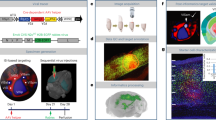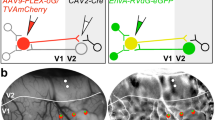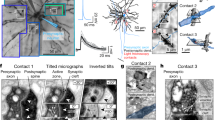Abstract
Information processing in neocortical circuits requires integrating inputs over a wide range of spatial scales, from local microcircuits to long-range cortical and subcortical connections. We used rabies virus–based trans-synaptic tracing to analyze the laminar distribution of local and long-range inputs to pyramidal neurons in the mouse barrel cortex and medial prefrontal cortex (mPFC). In barrel cortex, we found substantial inputs from layer 3 (L3) to L6, prevalent translaminar inhibitory inputs, and long-range inputs to L2/3 or L5/6 preferentially from L2/3 or L5/6 of input cortical areas, respectively. These layer-specific input patterns were largely independent of NMDA receptor function in the recipient neurons. mPFC L5 received proportionally more long-range inputs and more local inhibitory inputs than barrel cortex L5. Our results provide new insight into the organization and development of neocortical networks and identify important differences in the circuit organization in sensory and association cortices.
This is a preview of subscription content, access via your institution
Access options
Subscribe to this journal
Receive 12 print issues and online access
$209.00 per year
only $17.42 per issue
Buy this article
- Purchase on Springer Link
- Instant access to full article PDF
Prices may be subject to local taxes which are calculated during checkout








Similar content being viewed by others
References
Woolsey, T.A. & Van der Loos, H. The structural organization of layer IV in the somatosensory region (SI) of mouse cerebral cortex. The description of a cortical field composed of discrete cytoarchitectonic units. Brain Res. 17, 205–242 (1970).
Simons, D.J. Response properties of vibrissa units in rat SI somatosensory neocortex. J. Neurophysiol. 41, 798–820 (1978).
Guo, Z.V. et al. Flow of cortical activity underlying a tactile decision in mice. Neuron 81, 179–194 (2014).
Fuster, J.M. The prefrontal cortex: Anatomy, Physiology, and Neuropsychology of the Frontal Lobe (Academic Press, Philadelphia, 2008).
Douglas, R.J.M., Martin, K.A.C. & Whitteridge, D. A canonical microcircuit for the neocortex. Neural Comput. 1, 480–488 (1989).
Thomson, A.M. & Lamy, C. Functional maps of neocortical local circuitry. Front Neurosci 1, 19–42 (2007).
Douglas, R.J. & Martin, K.A. Neuronal circuits of the neocortex. Annu. Rev. Neurosci. 27, 419–451 (2004).
Lefort, S., Tomm, C., Floyd Sarria, J.C. & Petersen, C.C. The excitatory neuronal network of the C2 barrel column in mouse primary somatosensory cortex. Neuron 61, 301–316 (2009).
Hooks, B.M. et al. Laminar analysis of excitatory local circuits in vibrissal motor and sensory cortical areas. PLoS Biol. 9, e1000572 (2011).
Gilbert, C.D. & Wiesel, T.N. Morphology and intracortical projections of functionally characterised neurones in the cat visual cortex. Nature 280, 120–125 (1979).
Brown, S.P. & Hestrin, S. Intracortical circuits of pyramidal neurons reflect their long-range axonal targets. Nature 457, 1133–1136 (2009).
Callaway, E.M. & Katz, L.C. Photostimulation using caged glutamate reveals functional circuitry in living brain slices. Proc. Natl. Acad. Sci. USA 90, 7661–7665 (1993).
Hooks, B.M. et al. Organization of cortical and thalamic input to pyramidal neurons in mouse motor cortex. J. Neurosci. 33, 748–760 (2013).
Kätzel, D., Zemelman, B.V., Buetfering, C., Wolfel, M. & Miesenbock, G. The columnar and laminar organization of inhibitory connections to neocortical excitatory cells. Nat. Neurosci. 14, 100–107 (2011).
Petreanu, L., Huber, D., Sobczyk, A. & Svoboda, K. Channelrhodopsin-2–assisted circuit mapping of long-range callosal projections. Nat. Neurosci. 10, 663–668 (2007).
Wickersham, I.R. et al. Monosynaptic restriction of trans-synaptic tracing from single, genetically targeted neurons. Neuron 53, 639–647 (2007).
Callaway, E.M. & Luo, L. Monosynaptic circuit tracing with glycoprotein-deleted rabies viruses. J. Neurosci. 35, 8979–8985 (2015).
Miyamichi, K. et al. Dissecting local circuits: parvalbumin interneurons underlie broad feedback control of olfactory bulb output. Neuron 80, 1232–1245 (2013).
Olsen, S.R., Bortone, D.S., Adesnik, H. & Scanziani, M. Gain control by layer six in cortical circuits of vision. Nature 483, 47–52 (2012).
Kim, J., Matney, C.J., Blankenship, A., Hestrin, S. & Brown, S.P. Layer 6 corticothalamic neurons activate a cortical output layer, layer 5a. J. Neurosci. 34, 9656–9664 (2014).
Greig, L.C., Woodworth, M.B., Galazo, M.J., Padmanabhan, H. & Macklis, J.D. Molecular logic of neocortical projection neuron specification, development and diversity. Nat. Rev. Neurosci. 14, 755–769 (2013).
Gerfen, C.R., Paletzki, R. & Heintz, N. GENSAT BAC cre-recombinase driver lines to study the functional organization of cerebral cortical and basal ganglia circuits. Neuron 80, 1368–1383 (2013).
Bortone, D.S., Olsen, S.R. & Scanziani, M. Translaminar inhibitory cells recruited by layer 6 corticothalamic neurons suppress visual cortex. Neuron 82, 474–485 (2014).
Feldmeyer, D. Excitatory neuronal connectivity in the barrel cortex. Front Neuroanat. 6, 24 (2012).
Zhang, Z.W. & Deschenes, M. Intracortical axonal projections of lamina VI cells of the primary somatosensory cortex in the rat: a single-cell labeling study. J. Neurosci. 17, 6365–6379 (1997).
Isaacson, J.S. & Scanziani, M. How inhibition shapes cortical activity. Neuron 72, 231–243 (2011).
Li, J. & Schwark, H.D. Distribution and proportions of GABA-immunoreactive neurons in cat primary somatosensory cortex. J. Comp. Neurol. 343, 353–361 (1994).
Welker, E., Hoogland, P.V. & Van der Loos, H. Organization of feedback and feedforward projections of the barrel cortex: a PHA-L study in the mouse. Exp. Brain Res. 73, 411–435 (1988).
Porter, L.L. & White, E.L. Afferent and efferent pathways of the vibrissal region of primary motor cortex in the mouse. J. Comp. Neurol. 214, 279–289 (1983).
Mao, T. et al. Long-range neuronal circuits underlying the interaction between sensory and motor cortex. Neuron 72, 111–123 (2011).
Constantinople, C.M. & Bruno, R.M. Deep cortical layers are activated directly by thalamus. Science 340, 1591–1594 (2013).
Wimmer, V.C., Bruno, R.M., de Kock, C.P., Kuner, T. & Sakmann, B. Dimensions of a projection column and architecture of VPM and POm axons in rat vibrissal cortex. Cereb. Cortex 20, 2265–2276 (2010).
Beierlein, M. & Connors, B.W. Short-term dynamics of thalamocortical and intracortical synapses onto layer 6 neurons in neocortex. J. Neurophysiol. 88, 1924–1932 (2002).
Viaene, A.N., Petrof, I. & Sherman, S.M. Synaptic properties of thalamic input to layers 2/3 and 4 of primary somatosensory and auditory cortices. J. Neurophysiol. 105, 279–292 (2011).
Katz, L.C. & Shatz, C.J. Synaptic activity and the construction of cortical circuits. Science 274, 1133–1138 (1996).
Bi, G. & Poo, M. Synaptic modification by correlated activity: Hebb's postulate revisited. Annu. Rev. Neurosci. 24, 139–166 (2001).
Dantzker, J.L. & Callaway, E.M. The development of local, layer-specific visual cortical axons in the absence of extrinsic influences and intrinsic activity. J. Neurosci. 18, 4145–4154 (1998).
Datwani, A., Iwasato, T., Itohara, S. & Erzurumlu, R.S. NMDA receptor–dependent pattern transfer from afferents to postsynaptic cells and dendritic differentiation in the barrel cortex. Mol. Cell. Neurosci. 21, 477–492 (2002).
Espinosa, J.S., Wheeler, D.G., Tsien, R.W. & Luo, L. Uncoupling dendrite growth and patterning: single-cell knockout analysis of NMDA receptor 2B. Neuron 62, 205–217 (2009).
Iwasato, T. et al. Cortex-restricted disruption of NMDAR1 impairs neuronal patterns in the barrel cortex. Nature 406, 726–731 (2000).
De Felipe, J., Marco, P., Fairen, A. & Jones, E.G. Inhibitory synaptogenesis in mouse somatosensory cortex. Cereb. Cortex 7, 619–634 (1997).
White, E.L., Weinfeld, L. & Lev, D.L. A survey of morphogenesis during the early postnatal period in PMBSF barrels of mouse SmI cortex with emphasis on barrel D4. Somatosens. Mot. Res. 14, 34–55 (1997).
Hoover, W.B. & Vertes, R.P. Anatomical analysis of afferent projections to the medial prefrontal cortex in the rat. Brain Struct. Funct. 212, 149–179 (2007).
Vélez-Fort, M. et al. The stimulus selectivity and connectivity of layer six principal cells reveals cortical microcircuits underlying visual processing. Neuron 83, 1431–1443 (2014).
Zarrinpar, A. & Callaway, E.M. Local connections to specific types of layer 6 neurons in the rat visual cortex. J. Neurophysiol. 95, 1751–1761 (2006).
London, M. & Hausser, M. Dendritic computation. Annu. Rev. Neurosci. 28, 503–532 (2005).
Dilgen, J., Tejeda, H.A. & O'Donnell, P. Amygdala inputs drive feedforward inhibition in the medial prefrontal cortex. J. Neurophysiol. 110, 221–229 (2013).
De Marco García, N.V., Priya, R., Tuncdemir, S.N., Fishell, G. & Karayannis, T. Sensory inputs control the integration of neurogliaform interneurons into cortical circuits. Nat. Neurosci. 18, 393–401 (2015).
Ko, H. et al. Functional specificity of local synaptic connections in neocortical networks. Nature 473, 87–91 (2011).
Paxinos, G. & Franklin, K.B.J. The Mouse Brain in Stereotaxic Coordinates, Second Edition (Academic Press, 2001).
Gong, S. et al. Targeting Cre recombinase to specific neuron populations with bacterial artificial chromosome constructs. J. Neurosci. 27, 9817–9823 (2007).
Tsien, J.Z., Huerta, P.T. & Tonegawa, S. The essential role of hippocampal CA1 NMDA receptor–dependent synaptic plasticity in spatial memory. Cell 87, 1327–1338 (1996).
Madisen, L. et al. A robust and high-throughput Cre reporting and characterization system for the whole mouse brain. Nat. Neurosci. 13, 133–140 (2010).
Navarro-Quiroga, I., Chittajallu, R., Gallo, V. & Haydar, T.F. Long-term, selective gene expression in developing and adult hippocampal pyramidal neurons using focal in utero electroporation. J. Neurosci. 27, 5007–5011 (2007).
Osakada, F. & Callaway, E.M. Design and generation of recombinant rabies virus vectors. Nat. Protoc. 8, 1583–1601 (2013).
Weissbourd, B. et al. Presynaptic partners of dorsal raphe serotonergic and GABAergic neurons. Neuron 83, 645–662 (2014).
Brecht, M. et al. Organization of rat vibrissa motor cortex and adjacent areas according to cytoarchitectonics, microstimulation, and intracellular stimulation of identified cells. J. Comp. Neurol. 479, 360–373 (2004).
Acknowledgements
We thank K. Miyamichi for critical discussions while designing experiments, members of the Luo laboratory and K. Svoboda for helpful comments on the manuscript, P. Joshi and S. McConnell (Department of Biology, Stanford University) for Rbp4Cre and Ntsr1Cre mice, and C. Gerfen (Laboratory of Systems Neuroscience, National Institute of Mental Health) for SepW1Cre mice. L.L is an investigator of the Howard Hughes Medical Institute. This work was supported by US National Institutes of Health grants T32NS007280-27 and F32NS087860 (L.A.D.), F31DC013240 (D.S.B.) and R01-NS050835 (L.L.).
Author information
Authors and Affiliations
Contributions
L.A.D., D.S.B. and L.L. designed the experiments. L.A.D. and D.S.B. performed and analyzed layer-specific trans-synaptic tracing experiments. L.A.D. performed slice recording and CRACM experiments. K.D. performed and analyzed in situ hybridization experiments. L.A.D., D.S.B. and L.L wrote the manuscript.
Corresponding author
Ethics declarations
Competing interests
The authors declare no competing financial interests.
Integrated supplementary information
Supplementary Figure 1 Controls for rabies tracing
(a) Characterization of reagents and procedures. L2/3 neurons were electroporated in utero with pCAG-tdTomato and Cre-driver lines were crossed to Ai14 mice. Images show that tdTomato expression in barrel cortex was restricted to the intended layers at P21, and both Cre lines were active at P1. Individual barrels in L4 at P21 are outlined with dotted lines. (b) We observed 0 mCherry-positive or GFP-positive cells when tracing from wild-type mice that did not express Cre (n = 3 mice) using the trans-synaptic tracing experimental conditions. (c) Example image from a control tracing experiment when AAV carrying CAG-FLEx-G was omitted. Graphs show quantification of the number of red+green (yellow cells) divided by total green cells. (d) Tables list the lower limits (upper) and thicknesses (lower) of each layer for each set of experiments (IUEp-Cre, n = 6 mice; Rbp4Cre, n = 9 mice; Ntsr1Cre, n = 9 mice, layer markers, n = 6–8 sections from 2 mice). There were no significant differences between layer limits (Two-way ANOVA, F = 2.66, P = 0.07) or layer thicknesses (Two-way ANOVA, F = 1.39, P = 0.25). (e) Staining for layer markers Cux1 (L2-4) and Ctip2 (L5b/6) in barrel cortex. Scale bars represent 200 μm. Summary statistics presented as mean ± s.e.m. See Supplementary Table 6 for exact test results and P values.
Supplementary Figure 2 Characterization of Cre driver lines
(a) Characterization of SepW1Cre. SepW1Cre mice were injected with AAV carrying CAG-FLEx-TC66T-mCherry in barrel cortex at P25 and perfused at P40. Sections of barrel cortex were stained with antibodies against NeuN (n = 8 sections from 2 mice). (b-e) Characterization of Rbp4Cre. Brain sections from P40 Rbp4Cre;RosaAi14 mice were stained for NeuN or Ctip2. (b) NeuN staining in barrel cortex (n = 6 slices from 2 mice). (c) Ctip2 staining in barrel cortex (n = 12 slices from 2 mice). (d) NeuN staining in mPFC (n = 5 slices from 2 mice). (e) Ctip2 staining in mPFC (n = 5 slices from 2 mice). (f) Characterization of Ntsr1Cre. Barrel cortex sections from P40 Ntsr1Cre;RosaAi14 mice were stained for NeuN (n = 10 slices from 2 mice). (g) Quantification of marker colocalization. Summary statistics presented as mean ± s.e.m.
Supplementary Figure 3 Spatial analyses of Gad+ and Gad– synaptic inputs from barrel cortex to starter cells in L2/3, L5, and L6 along the M-L Axis
(a-f) Heat maps showing distribution of Gad– inputs (upper panels), Gad+ inputs (middle panels) and starter cells (SCs, lower panels) in each layer along the M-L axis (n = 3 mice each). Inputs to L2/3 (a), L5 (c), and L6 (e) scaled to highest fraction of Gad+ inputs. Inputs to L2/3 (b), L5 (d), and L6 (f) scaled to highest fraction of Gad– inputs. Colors represent fraction of barrel cortex inputs within the sections analyzed. Bin widths are 120 μm.
Supplementary Figure 4 Characterization of the EPSCs in control and GluN1-lacking neurons
(a) Example EPSCs recorded from a WT L6 neuron voltage-clamped at +40 mV while stimulating white matter. DNQX (blue trace) reduced the amplitude of the EPSC. (b) Example EPSCs recorded from a GluN1fl/Δ L6 neuron voltage-clamped at +40 mV while stimulating white matter. DNQX (blue trace) completely abolished the EPSC. (c) Quantification of fraction of EPSC remaining after DNQX wash-in (Control: 0.20 ± 0.07, n = 4 cells, from 2 mice; Grin1fl/Δ: 0.005 ± 0.001, n = 4 cells from 2 mice; P = 0.04, Student’s t-test). Summary statistics presented as mean s.e.m. See Supplementary Table 6 for exact test results and P values.
Supplementary Figure 5 Layer assignments for tracing from starter cells lacking GluN1 and comparison of long-range inputs to control and GluN1-lacking starter cells
(a) Layer limits were assigned based on the DAPI signal for each section. Table lists the lower limits of each layer for each set of experiments (IUEp-Cre;GluN1fl/Δ, n = 4 mice; Rbp4Cre;GluN1fl/Δ, n = 6 mice; Ntsr1Cre;GluN1fl/Δ, n = 7 mice). (b) Comparison of layer limits between control and GluN1fl/Δ animals. (c) Layer thicknesses derived from the limits based on DAPI signal within each section. Table lists the thickness of each layer for each set of experiments (IUEp-Cre;GluN1fl/Δ, n = 4 mice; Rbp4Cre;GluN1fl/Δ, n = 6 mice; Ntsr1Cre;GluN1fl/Δ, n = 7 mice). (d) Comparison of layer thickness between control and GluN1fl/Δ animals. (e) Laminar analysis of long-range inputs from to control (colors) and GluN1-lacking (black) starter cells in L5 from S1 (control: n = 9 mice; GluN1fl/Δ: n = 4 mice), S2 (control: n = 5 mice; GluN1fl/Δ: n = 5 mice; L6 comparison, P = 0.004), M1 (control: n = 7 mice; GluN1fl/Δ: n = 4 mice), and M2 (control: n = 5 mice; GluN1fl/Δ: n = 3 mice). (f) Laminar analysis of long-range inputs from to control (colors) and GluN1-lacking (black) starter cells in L6 from S1 (control: n = 9 mice; GluN1fl/Δ: n = 7 mice), S2 (control: n = 9 mice; GluN1fl/Δ: n = 7 mice; L6 comparison, P = 0.003), M1 (control: n = 8 mice; GluN1fl/Δ: n = 7 mice), and M2 (control: n = 8 mice; GluN1fl/Δ: n = 6 mice). * denotes significant P values from multiple t-tests with Holm-Sidak correction for multiple comparisons (α=0.05). Summary statistics presented as mean ± s.e.m. See Supplementary Table 6 for exact test results and P values.
Supplementary Figure 6 Controls for layer-specific tracing to mPFC
(a) Example images showing staining for layer markers Cux1 (L3) and Ctip2 (L5b/6). Scale bar represents 100 μm. (b) Summary of layer lower limits (upper) assigned based on DAPI or layer markers and layer thickness (lower) assigned based on DAPI or layer markers. (c) Example images showing rabies tracing in mPFC without CAG-FLEx-G. Green rabies-infected neurons have almost 100% overlap with red TVA66T-mCherry-positive neurons. (d) Results of control tracing experiments (n = 3 mice) without rabies glycoprotein, which mediates trans-synaptic spread. CAG-FLEx-TVA66T-mCherry was injected into Rbp4Cre animals in mPFC. Two weeks later, RVdG-EGFP was injected into the same location. Graphs show quantification of the sum of red+green (yellow) divided by the total green cells. (e) Comparison of layer distribution of total inputs to L5 of mPFC and barrel cortex, normalized by layer thickness for each respective area (mPFC: n = 4 mice; BC: n = 8 mice; L1: P = 6.31x10-6, L3: P = 0.0002). * denotes significant P values from multiple t-tests with Holm-Sidak correction for multiple comparisons (α=0.05). Summary statistics presented as mean ± s.e.m. See Supplementary Table 6 for exact test results and P values.
Supplementary Figure 7 Raw numbers of inputs and starter cells for tracing in Barrel Cortex and mPFC
Plots of raw numbers of inputs vs. starter cells (left) and convergence index (# inputs cells /# starter cells) (right) for barrel cortex (a) L2/3, (b) L5, and (c) L6, and (d) mPFC L5 tracing experiments. Summary statistics presented as mean±SEM.
Supplementary information
Supplementary Text and Figures
Supplementary Figures 1–7 and Supplementary Tables 1–6 (PDF 1567 kb)
Rights and permissions
About this article
Cite this article
DeNardo, L., Berns, D., DeLoach, K. et al. Connectivity of mouse somatosensory and prefrontal cortex examined with trans-synaptic tracing. Nat Neurosci 18, 1687–1697 (2015). https://doi.org/10.1038/nn.4131
Received:
Accepted:
Published:
Issue Date:
DOI: https://doi.org/10.1038/nn.4131
This article is cited by
-
GluN2B inhibition confers resilience against long-term cocaine-induced neurocognitive sequelae
Neuropsychopharmacology (2023)
-
Neocortical synaptic engrams for remote contextual memories
Nature Neuroscience (2023)
-
A whole-brain monosynaptic input connectome to neuron classes in mouse visual cortex
Nature Neuroscience (2023)
-
A molecularly integrated amygdalo-fronto-striatal network coordinates flexible learning and memory
Nature Neuroscience (2022)
-
Coordinated hippocampal-thalamic-cortical communication crucial for engram dynamics underneath systems consolidation
Nature Communications (2022)



